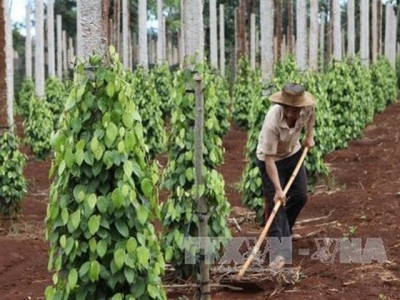Central Highlands pepper growers in debt as prices fall

Many pepper growers in the Central Highlands of Gia Lai are struggling to pay back bank loans as the price of black pepper has fallen to one-third of its peak during the “golden 2012-16 period”.—VNA/VNS Photo
GIA LAI – Pepper growers in the Central Highlands province of Gia Lai are facing debt as the price of black pepper has plunged in recent years.
According to figures from Gia Lai’s agricultural sector, the province’s black pepper growing area has expanded to 16,000ha, though only 6,000ha of pepper were officially planned by 2020.
Gia Lai, along with Đắk Lắk and Đắk Nông provinces, are the key pepper-producing areas in the country.
From 2012 to 2016, when the price of black pepper reached a peak of VNĐ220,000 (US$9.6) per kilogramme, locals rushed to grow the plant.
At that time, a large number of pepper growers grew rich from planting and selling pepper.
When pepper became a hot commodity, the price of pepper seedlings also increased from VNĐ3,000 to VNĐ5,000 each per kilogramme.
Apart from land costs, farmers typically invested VNĐ300-450 million per ha for four years before harvesting their first batch of peppercorns.
Many farmers used their land-use rights as collateral to get bank loans for pepper cultivation.
However, by the end of 2016, the price of pepper had plummeted to only VNĐ55,000-65,000 per kilogramme.
A pepper disease outbreak at the time also caused low yields, and, in many cases, massive death of plants.
A great number of pepper growers were then left with deep debt.
Total outstanding loans to pepper plantations in the province currently stand at VNĐ4 trillion, including VNĐ1 trillion in Chư Pưh District, one of the major pepper growing zones.
Now that the pepper price has declined to only one-third of its peak price, farmers whose sole income is from pepper are finding it difficult to pay back bank loans.
The low price of rubber and coffee has also affected dozens of thousands of farmers in the Central Highlands.
In an effort to help farmers generate more income, the province has been replacing traditional key farm produce such as rubber, coffee and pepper with fruit trees.
It now has around 7,200 ha of fruit, including banana, mango, durian and dragon fruit.
The province aims to expand the growing area to 10,000 hectares by 2020 with a focus on fruits with an officially recognised geographical indication.
Related news
 Rice export upbeat in first half
Rice export upbeat in first half Vietnam’s rice exports saw remarkable growth in the first six months of this year, with year-on-year increases of 24.6 percent in volume and 42.2 percent
 Ceres fruit farmer’s journey to success
Ceres fruit farmer’s journey to success From humble beginnings, Walter Williams has grown a business that today has three farms as well as a fruit packing business in the Ceres Valley
 Efforts made to boost Vietnamese fruit exports to China
Efforts made to boost Vietnamese fruit exports to China The activity was part of the agency’s efforts to help Vietnamese business to expand their exports to various markets around the world.